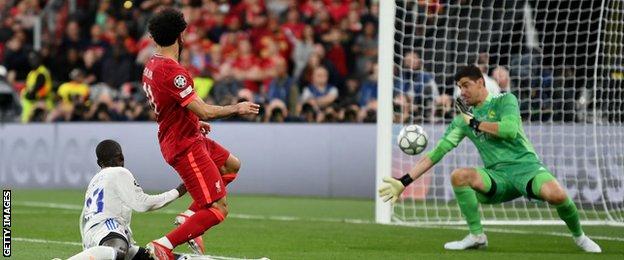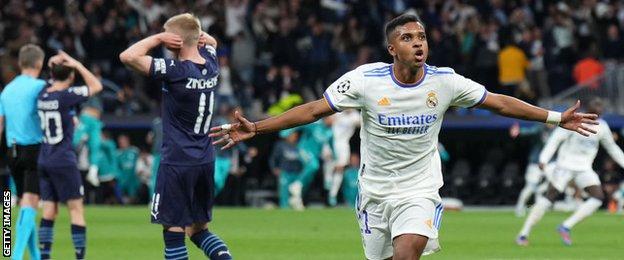Before May’s Champions League final, Carlo Ancelotti was asked what he thought of Liverpool.
“They have a lot of quality together, with high intensity and good organisation,” the Real Madrid manager said.
“Jurgen Klopp has brought some new things to football. He’s doing a great job.”
What he said after Real’s rope-a-dope 1-0 win revealed more though, suggesting that while Klopp’s side may be great at what they do, they are not able to do much else.
“Liverpool were easier to decipher than others,” Ancelotti told Sky Sport Italia.
“They have a very clear identity and we could prepare the way that we did. We knew what strategy to take.”
Uefa’s technical report of the tournament – an exhaustive analysis covering 125 matches, with observations from 23 experts including England manager Gareth Southgate – has illustrated how Real bucked tactical trends to take the prize.
Real surrender space to win war

Defend high, press hard, squeeze space and seize the day; for Klopp and others steering most of Europe’s superpowers, the philosophy has been clear for some time.
Manchester City, Bayern Munich and Liverpool all kept a stratospherically high defensive line in their Champions League campaigns.
During the knockout stages, their last defender was an average of 45.5m, 44.4m and 43.6m respectively up the pitch when out of possession.
Those were the three highest totals in the tournament. By contrast, Real Madrid sat back. They recorded 35.2m for the same statistic, the 10th highest among the last-16 teams.
With Ancelotti prioritising precision on the ball rather than pressure off it, Real’s rivals moved easily up the pitch.
Uefa measured the inroads the opposition made from each spell of possession. Only Sheriff Tiraspol and Dynamo Kyiv gave up more territory than Real.
Only Chelsea, Ajax and Atalanta offered up less than Liverpool.
Fabio Capello, one of Uefa’s experts and a former Real manager himself, saw it as a pragmatic choice based on personnel.
Real’s midfield trio of 30-year-old Casemiro (now at Manchester United), Toni Kroos, 32, and Luka Modric, 36, are long on years as well as trophies and technique.
“The midfielders are not young, not so fast,” Capello observed.
Courtois’ reach helps reel in title

Whenever Real were unable to keep the opposition at an arm’s length, they needed the long reach of their goalkeeper to bail them out.
Thibaut Courtois duly did, emerging as the dominant figure in the final.
The former Chelsea goalkeeper, peeved by a perceived lack of appreciation for his ability in England, made nine saves to deny Liverpool.
It was the most by a goalkeeper in a Champions League final on record. Courtois also made more saves than any other goalkeeper in the competition, with 59.
Most tellingly, he topped the standings for goals prevented.
The statistic, essentially the opposite of xG (expected goals), measures how a goalkeeper performed against the shots they faced.
Overall, against par, Courtois prevented 4.63 goals across Real’s run.
Attacking efficiency powers late comebacks

At the other end of the pitch, Real also performed better than the average.
Legendary France striker Karim Benzema, backed by Brazilian duo Rodrygo and Vinicius Junior, was ruthless.
On the spreadsheet, Real Madrid’s xG after the group stage was 21.78. However, on the pitch they managed to hit the net 29 times.
Those goals often came at the end of patient, probing periods of possession, rather than the warp-speed attacks of their high-pressing rivals or the more direct back-to-front style of the competition’s underdogs.
Real Madrid had the ball for an average of 16.2 seconds before each goal, more than any other team that reached the knockout stages.
Again, Liverpool provided a contrast. Klopp’s break-neck side had the ball for an average of 9.5 seconds before finding the net.
Some elements to Real’s success were harder to measure.
With 15 minutes to go of their last-16 tie against Paris St-Germain, they were heading out.
With 10 minutes to go of their quarter-final against Chelsea, they were heading out.
With five minutes of added time left against Manchester City, they were heading out.
Each time, they slipped out of the stranglehold and into the next round.
Outrageous good fortune? Outstanding mental fortitude? A bit of both?
Maybe that’s why Ancelotti kept his summary simple after the final.
“Vinicius scored a goal, Courtois made saves, end of story!” he said.
How Real got there was far from simple though.
Source: BBC


